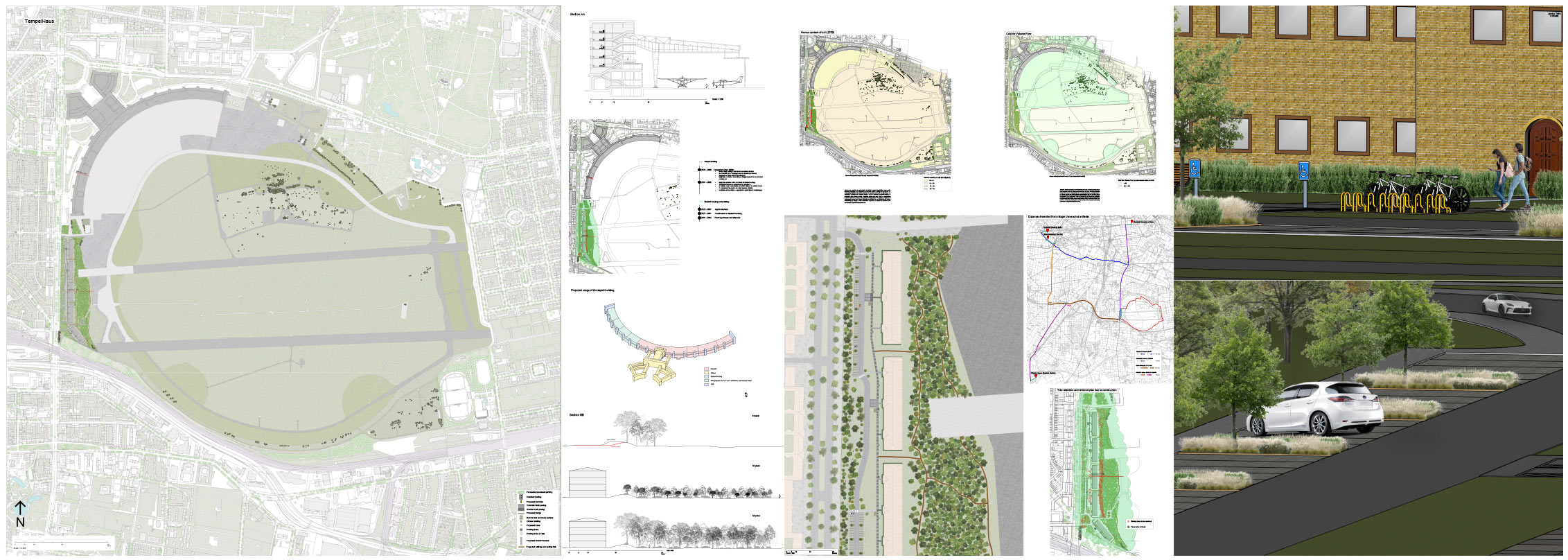

Janka Toth
TempelHaus
Berlin is currently facing a major housing shortage, with rising rents making affordable accommodation increasingly difficult to find, especially for students. Around 4,900 students are currently on waiting lists for housing. Only 5% of Berlin’s students live in student dormitories, well below the national average of 10%. The situation shows worrying signs of further deterioration. The urgent need for affordable student housing in Berlin demands solutions that are both sustainable and sensitive to the city's historical context and public values. The west side of Tempelhofer Feld (“TF”) has been identified as ideal, as it benefits from excellent public transport connections and proximity to Berlin’s largest universities, making it highly accessible for students.
My proposal addresses this crisis by introducing new student housing on TF. The proposal is designed to align with the 2014 public referendum, which opposed large-scale development on the site, by preserving the open, communal character of TF and concentrating development within a defined, carefully integrated zone. By limiting the extent of construction and strengthening the surrounding green landscape, the design minimises visual intrusion, enhances ecological value, and safeguards the site's critical role in Berlin’s urban climate system.
Tempelhof Airport serves as a vital cold air corridor for Berlin. The openness of the site facilitates the formation of cooler air masses, which flow into the surrounding urban areas and help reduce nighttime temperatures and improve air quality. Disruption to this natural ventilation could intensify the urban heat island effect, leading to higher nighttime temperatures and reduced air exchange. To mitigate this, the proposal strengthens the site’s resilience by introducing strategic tree plantings. Planting native tree species such as Fagus sylvatica, Quercus robur, Tilia cordata, Acer campestre, and Betula pendula will strengthen the site's cooling function by providing shade, reducing surface temperatures, and regulating humidity through natural transpiration processes.
The site’s soil conditions present a challenge. The ground at TF is unsuitable for healthy plant growth due to a low humus content. The soil quality will be improved by incorporating organic compost, sowing green manure crops, and adding biochar amendments. This will enrich soil structure, boost microbial activity, and enhance water retention to ensure the successful establishment of vegetation.
On the western edge of TF, five student accommodation buildings will be constructed. Their design reflects the architectural character and scale of the surrounding area, ensuring a respectful integration into the urban context. The space formerly occupied by the abandoned railway infrastructure will be reimagined as a green ecological corridor, creating new habitats for local biodiversity and serving as a natural buffer between the new development and the wider open field. A new parking area will be introduced just south of the existing one on the site’s west side.
In alignment with the broader Tempelhof 2030+ modernisation plan, further development will occur within the historic airport building. Once modernisation is complete, the towers will be converted into student residences, while the hangars will be repurposed into a mixed-use space housing a museum, café, and multi-functional event venue. These additions will create a dynamic social and cultural hub for students and the wider community. The Tempelhof Museum will be relocated into the hangars to provide a more immersive experience, while the airport’s existing office spaces will be refurbished into flexible, modern workspaces aligned with the 2030+ vision.
This proposal carefully balances the urgent need for student housing with the cultural, environmental, and social values of TF. Through context-sensitive planning, carefully managed development, and a strong focus on biodiversity and climate resilience, the project offers a thoughtful, sustainable response to Berlin’s urban challenges, aiming to deliver meaningful long-term benefits while respecting the site's cultural and ecological significance.